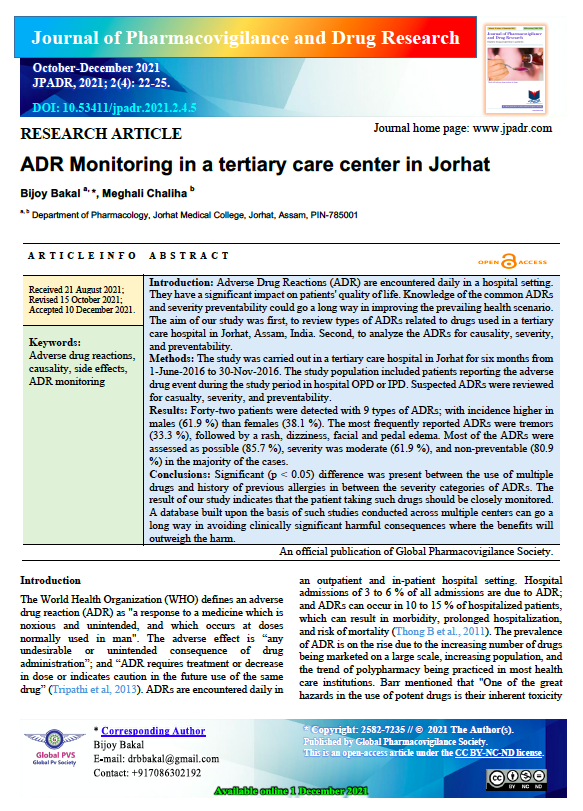ADR Monitoring in a tertiary care centre in Jorhat.
Research Article
Abstract
Introduction: Adverse Drug Reactions (ADR) are encountered daily in a hospital setting. They have a significant impact on patients' quality of life. Knowledge of the common ADRs and severity preventability could go a long way in improving the prevailing health scenario. The aim of our study was first, to review types of ADRs related to drugs used in a tertiary care hospital in Jorhat, Assam, India. Second, to analyze the ADRs for causality, severity, and preventability.
Methods: The study was carried out in a tertiary care hospital in Jorhat for six months from 1-June-2016 to 30-Nov-2016. The study population included patients reporting the adverse drug event during the study period in hospital OPD or IPD. Suspected ADRs were reviewed for casualty, severity, and preventability.
Results: Forty-two patients were detected with 9 types of ADRs; with incidence higher in males (61.9 %) than females (38.1 %). The most frequently reported ADRs were tremors (33.3 %), followed by a rash, dizziness, facial and pedal edema. Most of the ADRs were assessed as possible (85.7 %), severity was moderate (61.9 %), and non-preventable (80.9 %) in the majority of the cases.
Conclusions: Significant (p < 0.05) difference was present between the use of multiple drugs and history of previous allergies in between the severity categories of ADRs. The result of our study indicates that the patient taking such drugs should be closely monitored. A database built upon the basis of such studies conducted across multiple centers can go a long way in avoiding clinically significant harmful consequences where the benefits will outweigh the harm.
Downloads
References
Cdsco.gov.in. 2019[cited 20 August 2019]. Available from: https:// cdsco.gov.in /opencms /export/sites/CDSCO_WEB/Pdf-documents/ Consumer_Section_PDFs /ADRRF_2. pdf. Tripathi K. Essentials of medical pharmacology. 7th ed. New Delhi: Jaypee Brothers Medical Publishers (P) Ltd; 2013.
Lazarou, J., Pomeranz, B. H., & Corey, P. N. (1998). Incidence of adverse drug reactions in hospitalized patients: a meta-analysis of prospective studies. JAMA, 279(15), 1200–1205.
Naranjo, C. A., Busto, U., Sellers, E. M., Sandor, P., Ruiz, I., Roberts, E. A., Janecek, E., Domecq, C., & Greenblatt, D. J. (1981). A method for estimating the probability of adverse drug reactions. Clinical pharmacology and therapeutics, 30(2), 239–245.
Pourpak, Z., Fazlollahi, M. R., & Fattahi, F. (2008). Understanding adverse drug reactions and drug allergies: principles, diagnosis and treatment aspects. Recent patents on inflammation & allergy drug discovery, 2(1), 24–46.
Srinivasan, R., and Ramya, G. (2011). Adverse drug reaction-causality assessment. IJRPC, 1(3), 606-12.
Schumock, G. T., & Thornton, J. P. (1992). Focusing on the preventability of adverse drug reactions. Hospital pharmacy, 27(6), 538.
Thong, B. Y., & Tan, T. C. (2011). Epidemiology and risk factors for drug allergy. British journal of clinical pharmacology, 71(5), 684–700.
Tripathi, K. (2013). Essentials of medical pharmacology. 7th ed. New Delhi: Jaypee Brothers Medical Publishers (P) Ltd.
Wiffen. P., Gill, M., Edwards, J., Moore, A. (2002). Adverse drug reactions in hospital patients. A systematic review of the prospective and retrospective studies. Bandolier Extra. Evidence based health care, June 2002, 01-15.

Copyright (c) 2021 Bijoy Bakal

This work is licensed under a Creative Commons Attribution-NonCommercial-NoDerivatives 4.0 International License.









